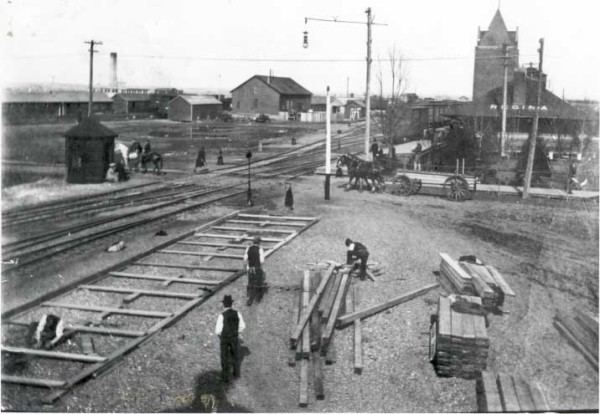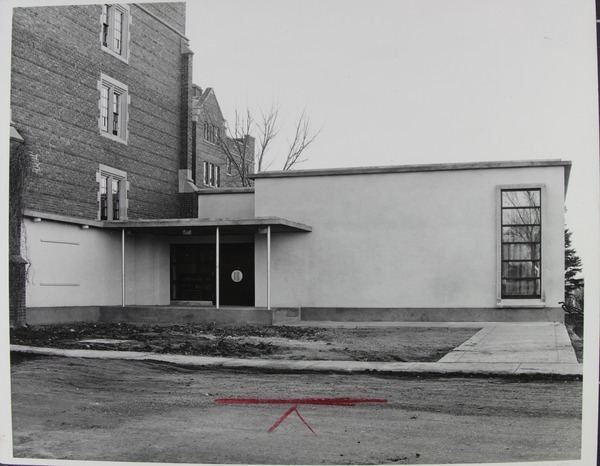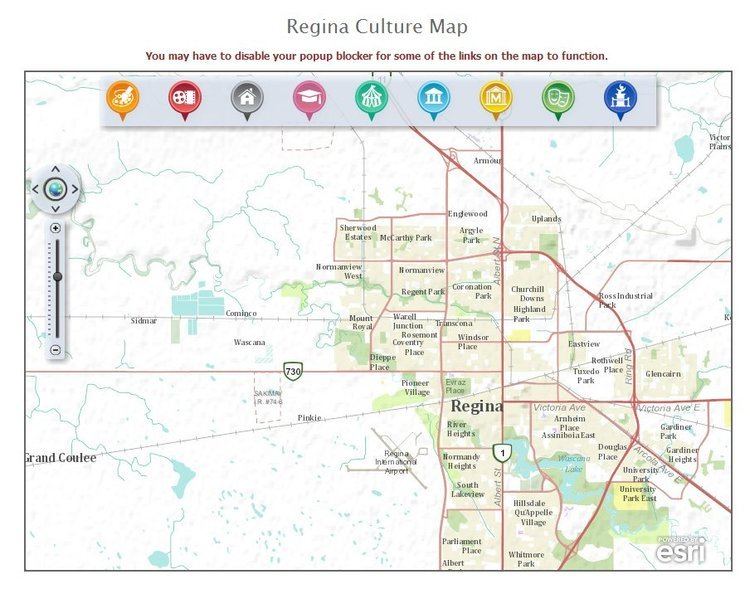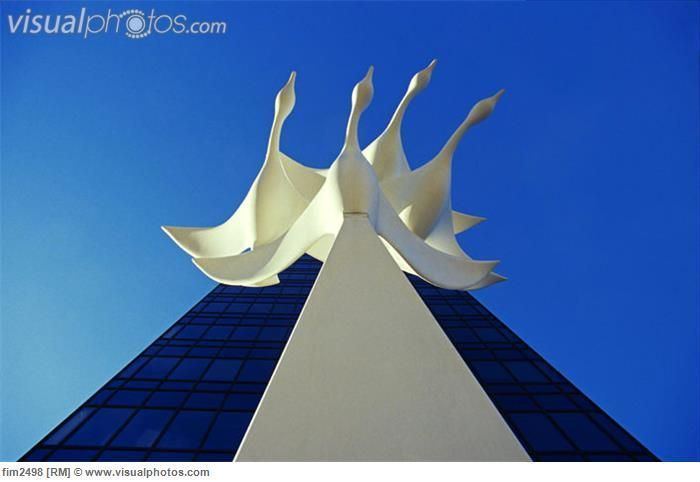Country Canada Population 179,245 (2006) Area 145.5 km2 | Founded 1882 Mayor Michael Fougere | |
Points of interest Royal Saskatchewan Museum, Wascana Centre, Saskatchewan Science Centre, MacKenzie Art Gallery, Saskatchewan Legislative Building Colleges and Universities University of Regina, Saskatchewan Institute of Applied Science and Technology - Wascana, First Nations University of Canada, Luther College, Western Christian College | ||
Regina ( Assiniboine: huhuzubina; Cree: oskana ka-asasteki) is the capital city of the Canadian province of Saskatchewan. The city is the second-largest in the province and a cultural and commercial centre for southern Saskatchewan. It is governed by Regina City Council. Regina is the cathedral city of the Roman Catholic and Romanian Orthodox Dioceses of Regina and the Anglican Diocese of QuAppelle. The city is surrounded by the Rural Municipality of Sherwood No. 159. In 2013, Regina was named the 6th best Canadian mid-sized city (17th best overall) in which to live by MoneySense magazine.
Contents
- Map of Regina Saskatchewan
- I love regina sk canada
- 1st place regina sk regional dragunity deck
- History
- Geography and climate
- Economy
- Culture
- Parks and outdoor attractions
- Visitor attractions
- Regina Saskatchewan cuisine
- References
Map of Regina, Saskatchewan
Regina was previously the seat of government of the North-West Territories, of which the current provinces of Saskatchewan and Alberta originally formed part, and of the District of Assiniboia. The site having previously been Wascana ("Buffalo Bones" in Cree), it was renamed in 1882 after Queen Victoria, Victoria Regina, by her daughter Princess Louise, wife of the Marquess of Lorne, then the Governor General of Canada.
I love regina sk canada
Unlike other planned cities in the Canadian West, on its treeless flat plain Regina has few topographical features other than the small spring run-off, Wascana Creek. Early planners took advantage of such opportunity by damming the creek to create a decorative lake to the south of the central business district with a dam a block and a half west of the later elaborate 840-foot (260 m) long Albert Street Bridge across the new lake. Reginas importance was further secured when the new province of Saskatchewan designated the city its capital in 1906. Wascana Centre, created around the focal point of Wascana Lake, remains one of Reginas attractions and contains the Provincial Legislative Building, both campuses of the University of Regina, the provincial museum of natural history, the Regina Conservatory (in the original Regina College buildings), the Saskatchewan Science Centre, the MacKenzie Art Gallery and the Saskatchewan Centre of the Arts.
1st place regina sk regional dragunity deck
Residential neighbourhoods include precincts beyond the historic city centre are historically or socially noteworthy neighbourhoods – namely Lakeview and The Crescents both of which lie directly south of downtown. Immediately to the north of the central business district is the old warehouse district, increasingly the focus of shopping, nightclubs and residential development; as in other western cities of North America, the periphery contains shopping malls and big box stores.
In 1912, the Regina Cyclone destroyed much of the town; in the 1930s, the Regina Riot brought further attention and, in the midst of the 1930s drought and Great Depression, which hit the Canadian Prairies particularly hard with their economic focus on dry land grain farming. The CCF (now the NDP, a major left-wing political party in Canada), formulated its foundation Regina Manifesto, 1933 in Regina. In recent years, Saskatchewans agricultural and mineral resources have come into new demand, and it has entered a new period of strong economic growth.
The current estimate of the Regina CMA population, as of 1 July 2013, according to Statistics Canada is 232,090.
History

Regina was established in 1882 when it became clear that Edgar Dewdney, the lieutenant-governor of the North-West Territories, eschewed the previously established and considered Battleford, Troy and Fort QuAppelle (the latter some 30 mi (48 km) to the east, one on rolling plains and the other in the QuAppelle Valley between two lakes), as the territorial seat of government: these were widely considered more amiable locations for what was anticipated would be a far more major metropole for the Canadian plains than actually eventuated, situated as they were in amply watered and treed rolling parklands whereas "Pile-of-Bones," as the site was then called, was in the midst of arid and featureless grassland.

Lieutenant-Governor Dewdney had acquired land adjacent to the route of the future CPR line at Pile-of-Bones, which was distinguished only by collections of bison bones near a small spring run-off creek, some few kilometres downstream from its origin in the midst of what are now wheat fields. There was an "obvious conflict of interest" in Dewdneys choosing the site of Pile-of-Bones as the territorial seat of government and it was a national scandal at the time. But until 1897, when responsible government was accomplished in the Territories, the lieutenant-governor and council governed by fiat and there was little legitimate means of challenging such decisions outside the federal capital of Ottawa. There, the Territories were remote and of little concern. Princess Louise, Duchess of Argyll, wife of the then Governor General of Canada, named the new community Regina, after her mother, the Queen.
Commercial considerations prevailed and the towns authentic development soon began as a collection of wooden shanties and tent shacks clustered around the site designated by the CPR for its future station, some two miles (3 km) to the east of where Dewdney had reserved substantial landholdings for himself and where he sited the Territorial (now the Saskatchewan) Government House.
Geography and climate

The city is situated on a broad, flat, treeless and largely waterless plain, except for a large underground aquifer – at the time of its founding, a matter of national scandal and notoriety as to corrupt dealings at the time, since it is immediately adjacent to amply watered and treed rolling parklands.

There is an abundance of parks and greenspaces: all of its trees — some 300,000 — shrubs and other plants were hand-planted. As in other prairie cities, American elms were planted in front yards in residential neighbourhoods and on boulevards along major traffic arteries and are the dominant species in the urban forest.
In recent years the pattern of primary and high school grounds being acreages of prairie sports grounds has been re-thought and such grounds have been landscaped with artificial hills and parks. Newer residential subdivisions in the northwest and southeast have, instead of spring runoff storm sewers, decorative landscaped lagoons.
The streetscape is now endangered by Dutch elm disease, which has spread through North America from the eastern seaboard and has now reached the Canadian prairies; for the time being it is controlled by pest management programs and species not susceptible to the disease are being planted; the disease has the potential to wipe out Reginas elm population.
Economy
Oil and natural gas, potash, kaolin, sodium sulphite and bentonite contribute a great part of Regina and areas economy. The completion of the train link between eastern Canada and the then-District of Assiniboia in 1885, the development of the high-yielding and early-maturing Marquis strain of wheat and the opening of new grain markets in the United Kingdom established the first impetus for economic development and substantial population settlement. The farm and agricultural component is still a significant part of the economy – the Saskatchewan Wheat Pool (now Viterra Inc.,), "the worlds largest grain-handling co-operative" has its headquarters in Regina — but it is no longer the major driver; provincially it has slipped to eighth overall, well behind the natural resources sectors.
Culture

Regina has a substantial cultural life in music, theatre and dance, supported by the fine arts constituency at the University of Regina, which has faculties of music, theatre and arts. At various times this has attracted notable artistic talent: the Regina Five were artists at Regina College (the Universitys predecessor) who gained national fame in the 1950s. The long-established MacKenzie Art Gallery once occupied cramped quarters adjacent to Darke Hall on the University of Regina College Avenue Campus; since relocated to a large building at the southwest corner of the provincial government site, at Albert Street near 23rd Avenue. Donald M. Kendrick, Bob Boyer and Joe Fafard, now with significant international reputations, have been other artists from or once in Regina. The Regina Symphony Orchestra (Canadas oldest continuously performing orchestra) performs in the Saskatchewan Centre of the Arts (now the Conexus Arts Centre). Concerts and recitals are performed both by local and visiting musicians in the Centre of the Arts and assorted other auditoriums including the University of Regina. The Regina Conservatory of Music operates in the former girls residence wing of the Regina College building. Annual festivals in and near Regina through the year include the Cathedral Village Arts Festival; the Craven Country Jamboree; the Regina Folk Festival; Queen City Pride; the Regina Dragon Boat Festival; and Mosaic, mounted by the Regina Multicultural Council, which earned Heritage Canada’s designation of 2004 "Cultural Capital of Canada" (in the over 125,000 population category). The annual Kiwanis Music Festival affords rising musical talents the opportunity to achieve nation-wide recognition. The citys summer agricultural exhibition was originally established in 1884 as the Assiniboia Agricultural Association and since the mid-1960s has been styled "Buffalo Days".

"[t]he Regina Little Theatre began in 1926, and performed in Regina College before building its own theatre in 1981," Regina lacked a large concert and live theatre venue for many years after the loss to fire of the Regina Theatre in 1938 and the demolition of the 1906 City Hall in 1964 at a time when preservation of heritage architecture was not yet a fashionable issue. But until the demolition of downtown cinemas which doubled as live theatres the lack was not urgent, and Darke Hall on the Regina College campus of the university provided a small concert and stage venue. (See Reginas historic buildings and precincts.)
This was remedied in 1970 with the construction of the Saskatchewan Centre of the Arts (now the Conexus Arts Centre) as a Canadian Centennial project, a theatre and concert hall complex overlooking Wascana Lake which is one of the most acoustically perfect concert venues in North America; it is home to the Regina Symphony Orchestra (Canadas oldest continuously performing orchestra), Opera Saskatchewan and New Dance Horizons, a contemporary dance company. The Royal Saskatchewan Museum (the present 1955 structure a Saskatchewan Golden Jubilee project) dates from 1906. The old Post Office at Scarth Street and 11th Avenue, temporarily used as a city hall after the demolition of the 1906 City Hall, is now home to the Globe Theatre, founded in 1966 as "Saskatchewans first professional theatre since 1927." Holy Rosary Roman Catholic Cathedral and Knox-Metropolitan United Church have particularly impressive Casavant Freres pipe organs, maintain substantial musical establishments and are frequently the venues for choral concerts and organ recitals.
The Regina Public Library is a city-wide library system with nine branches. Its facilities include the RPL Film theatre which plays non-mainstream cinema, the Dunlop Art Gallery, special literacy services and a prairie history collection. The MacKenzie Art Gallery in Wascana Centre and the Dunlop Art Gallery have permanent collections and sponsor travelling exhibitions. The Saskatchewan Archives and the Saskatchewan Genealogical Library also offer information for those interested in the people of Saskatchewan.
Parks and outdoor attractions
Regina has a substantial proportion of its overall area dedicated as parks and greenspaces, with biking paths, cross-country ski-ing venues and other recreational facilities throughout the city; Wascana Lake, the venue for summer boating activities, is regularly cleared of snow in winter for skating and there are toboggan runs both in Wascana Centre and downstream on the banks of Wascana Creek. Victoria Park is in the central business district and numerous greenspaces throughout the residential subdivisions and newer subdivisions in the north and west of the city contain large ornamental ponds to add interest to residential precincts such as Rochdale, Lakewood, Lakeridge, Spruce Meadows and Windsor Park; older school playing fields throughout the city have also been converted into landscaped parks.
The City operates five municipal golf courses, including two in Kings Park northeast of the city. Kings Park Recreation facility is also home to ball diamonds, picnic grounds, and stock car racing. Within half an hours drive are the summer cottage and camping country and winter ski resorts in the QuAppelle Valley with Last Mountain and Buffalo Pound Lakes and the four Fishing Lakes of Pasqua, Echo, Mission and Katepwa; slightly farther east are Round and Crooked Lakes, also in the QuAppelle Valley, and to the southeast the Kenosee Lake cottage country.
Wascana Centre is a 9.3 km2 (3.6 sq mi) park built around Wascana Lake and designed in 1961 by Minoru Yamasaki — the Seattle-born architect best known as the designer of the original World Trade Center in New York – in tandem with his starkly modernist design for the new Regina Campus of the University of Saskatchewan. Wascana Lake was created as a "stock watering hole" — for the CPRs rolling stock, that is – in 1883 when a dam and bridge were constructed 1½ blocks to the west of the present Albert Street Bridge. A new dam and bridge were built in 1908, and Wascana Lake was used as a domestic water source, to cool the city’s power plant and, in due course, for the new provincial legislative building.
By the 1920s, with Boggy Creek as a source of domestic water and wells into the aquifer under Regina. Wascana Lake had ceased to have a utilitarian purpose and had become primarily a recreational facility, with bathing and boating its principal uses. It was drained in the 1930s as part of a government relief project; 2,100 men widened and dredged the lake bed and created two islands using only hand tools and horse-drawn wagons.
During the fall and winter of 2003–2004, Wascana Lake was again drained and dredged to deepen it while adding a new island, a promenade area beside Albert Street Bridge, water fountains, and a waterfall to help aerate the lake.
Downstream from Wascana Lake Wascana Creek continues to provide a lush parkland on its increasingly intensively developed perimeter; in the northwest quadrant of the city Wascana Creek has a second weir with a smaller reservoir in A.E. Wilson Park.
Visitor attractions
Regina is a travel destination for residents of southeastern Saskatchewan and the immediately adjacent regions of the neighbouring US States of North Dakota and Montana, and an intermediate stopping point for travellers on the Trans-Canada Highway. Attractions for visitors in Regina include:
The former large-scale Childrens Day Parade and Travellers Day Parade during Fair Week in the summer, which were substantially supported by the Masons and Shriners, has become the fair parade as such service clubs have lost vitality: the Regina Exhibitions travelling midway divides its time among other western Canadian and US cities. A Santa Claus parade is now mounted during the lead-up to Christmas.
Regina, Saskatchewan cuisine

Pemmican and bannock are a few of the historical foods of the Cree first nation aboriginal peoples. Bannock is easy to prepare and combine with local berries, the dough can be cooked over the open fire suspended on willow stick, and tastes similar to biscuits. Early settlers survived by learning from the first nations which flora and fauna of the land were edible and how to prepare. Thereafter, the land was tilled, and agricultural practices and trading economies allowed each ethnic group to plant and cultivate the foods necessary for the recipes of their home land. Each ethnic group has brought their unique flavour and recipes to Saskatchewan and are celebrated today in Folk Festivals across the province.
